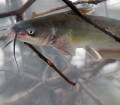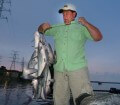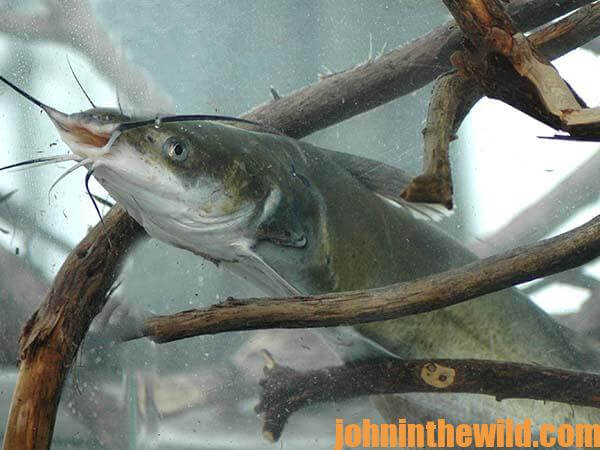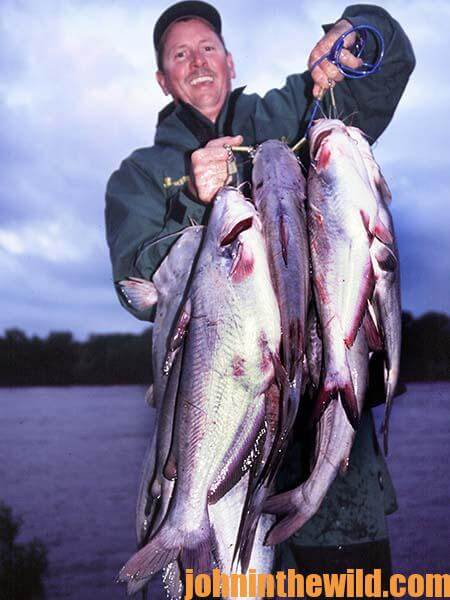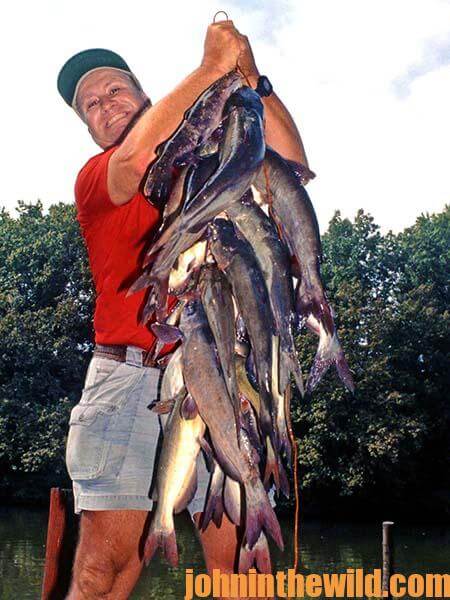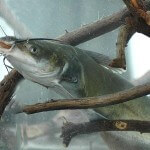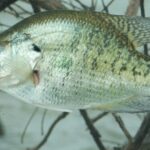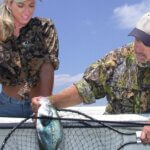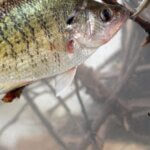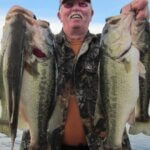John’s Note: Even when the singer’s the same and the music’s the same, most songs mean something different to every listener. However, there’s one song that evokes the same emotion in all of us, and that’s the song sung by a drag as line hums off the spool, the rod bows, and our muscles tighten. A fighting fish captures much of the essence of angling: the anticipation of what may be at the end of the line; the agony of whether or not the angler can subdue the critter before it escapes; the ecstasy of seeing that dark shadow just under the surface of the water at the end of the line; the sheer joy of excitement as the net is slipped under the fish; and the anticipation of the delicious meal that the fish will provide – especially if it’s a catfish. The taste of Mr. Whiskers has so enraptured the taste buds of anglers that in many states, raising and selling catfish has become a business more important than selling cotton, soybeans, corn and peanuts. However, there are still tons of catfish swimming rivers, lakes and streams throughout the nation, and these fish are free to the anglers who know how to take them. But, because competition for the cats is increasing, the angler who consistently wants to catch a mess of fish home for supper must develop better tactics for finding and taking them.
“Besides fishing the mouths of the creeks, I like fishing the outside bends of either the river channel or the major creek channels,” catfish guide Jim Perry (see Day 4) says.
“Although the inside bends will often be soft and muddy, because they’re protected from the current, the outside bends will most often have harder bottoms of either clay or rock, because they’re constantly being swept clean by the current. I’ve learned that catfish generally prefer the harder bottom to the softer bottom. Once I locate one of these deepwater areas, I usually circle the site with my boat and look for fish on my depth finder. Often I’ll spot clouds of fish – usually shad. But, I’ve noticed that when I see those clouds of shad, I usually spot some other bigger fish holding just below the shad or to the left or right of them. Sometimes these fish are catfish. So, I drop a buoy on what I believe to be the cats and then try to catch them.”
Of course, finding the catfish is only half the battle, because the angler must have the right equipment and the proper techniques to catch catfish. Perry likes a fairly-stiff rod, to set the hooks solidly when the cats take the baits in deep water. He’ll often fish from 12- to 20-pound-test line. On the very end of the line, Perry ties a bell sinker weighing one to 1-1/2-ounces, depending on the strength of the current. Over the top of the weight, he fashions a loop and ties a double overhand knot to make a drop line off the main line. He takes the loop end of the drop line and runs it through the eye of a No. 1 Eagle Claw hook with a bait keeper on the hook. For bait, Perry prefers using shiners. Perry kills a live shiner, then threads the hook through the minnow, running it through the minnow’s head and body and out near its tail.
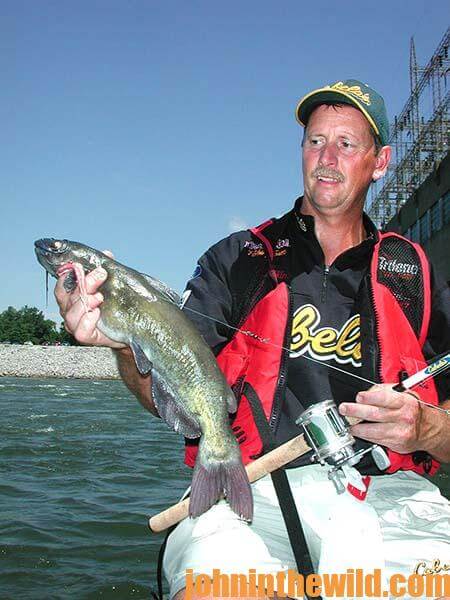 “Baiting like this helps the minnow to remain on the hook better, and it catches more fish,” Perry says. “I kill the minnow, since I want a fresh bait but not a live bait. Remember, that just about every kind of fish that swims will hole up in the regions I’m fishing. And, if you put a live minnow down in those spots, you’re going to catch crappie, bass, white bass, hybrids, drum and others. However, if you kill the bait, your chances of catching catfish are much better.” Minnows are not the only bait that Perry fishes with in the summertime. Big night crawlers, chicken livers and catalpa worms are also productive catfish baits. On any given day, one of these baits usually will catch more cats than the other. Although minnows are my favorite bait, generally I have chicken livers and some worms on hand just in case the catfish are picky about what they’re eating that day.
“Baiting like this helps the minnow to remain on the hook better, and it catches more fish,” Perry says. “I kill the minnow, since I want a fresh bait but not a live bait. Remember, that just about every kind of fish that swims will hole up in the regions I’m fishing. And, if you put a live minnow down in those spots, you’re going to catch crappie, bass, white bass, hybrids, drum and others. However, if you kill the bait, your chances of catching catfish are much better.” Minnows are not the only bait that Perry fishes with in the summertime. Big night crawlers, chicken livers and catalpa worms are also productive catfish baits. On any given day, one of these baits usually will catch more cats than the other. Although minnows are my favorite bait, generally I have chicken livers and some worms on hand just in case the catfish are picky about what they’re eating that day.
“I remember one day I was on a river ledge, and a man was fishing up-current from me. Almost every time the fellow let his line down to the bottom, he caught a cat that I guessed weighed 3 to 5 pounds. But, I hadn’t had a bite all morning. I was totally exasperated, so I motored up beside the fellow and said, ‘Het buddy, what are you baiting with?’ He answered, ‘Chicken livers,’ and then asked what I was using. I explained that I’d been fishing with minnows. The man chuckled and said, ‘I tried minnows and couldn’t get a bite. However, if you’ll use chicken livers, you’ll find that they seem to be what the catfish are wanting today.’ Luckily, I had some chicken livers in my ice chest. Once I switched my bait, I changed my luck. Yet, another good bait is the catalpa worm, which really isn’t a worm but rather is a caterpillar that eats the leaves of catalpa trees and is found around much of the Eastern United States. Because these caterpillars only remain on the trees for a few short weeks, many catfishermen gather and freeze the catalpa worms and then thaw them when they go fishing for cats when the worms are no longer around.”
One of the advantages of using the catalpa worms is the caterpillar is a tough-skinned critter, so anglers often can catch two or three catfish on the same worm before the bait is gone. When Perry is ready to fish, he moves to the front of the boat, watches his depth finder and uses his trolling motor to stay over the area and in the spot that he wants to fish. Many times the current coming through the lake is so strong that if Perry were to anchor, his bait would be washed past the region he wants to fish. Try these tactics to catch more catfish.
“Click here to get these books.”
About the Author
John Phillips, winner of the 2012 Homer Circle Fishing Award for outstanding fishing writer by the American Sportfishing Association (AMA) and the Professional Outdoor Media Association (POMA), the 2008 Crossbow Communicator of the year and the 2007 Legendary Communicator chosen for induction into the National Fresh Water Hall of Fame, is a freelance writer (over 6,000 magazine articles for about 100 magazines and several thousand newspaper columns published), magazine editor, photographer for print media as well as industry catalogues (over 25,000 photos published), lecturer, outdoor consultant, marketing consultant, book author and daily internet content provider with an overview of the outdoors. Click here for more information and a list of all the books available from John E. Phillips.

